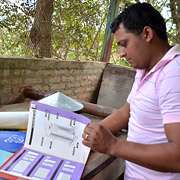 Management of the POSTCOSECHA strategy in Central America was carried out by independent project management units (PMUs) within the national Ministries of Agriculture.
Management of the POSTCOSECHA strategy in Central America was carried out by independent project management units (PMUs) within the national Ministries of Agriculture.
The main activities of those PMUs included program planning, coordination of actors and activities, organization of training courses, quality control, and controlling. The role of the PMUs changed during the roughly 10 year life span of the aid sponsored program in a country. The main phases were:
1 year introduction period
establishing contacts | contracting partner institutions | training of extension officers | pilot introductions of technology
4 years development period
promotion of technology | training of extension officers and tinsmiths | organization of raw material and credit supply chains | introduction of mass production of silos | introduction of quality standards
4 years consolidation period
organization of networks (extension officers, tinsmiths, promotion institutions) | quality control and transfer of control authority to national partners and networks | management of institutional relationships
2 years disengagement period
capacity development for problem solving | phasing out of cooperation contracts
|
Main critical program management factors
Transaction costs: the management structure adopted in Central America corresponded to normal aid modalities of that time, which from today’s perspective entail high transaction costs (calculated over the entire lifespan of the program, transaction costs and overall value of silos disseminated are roughly on the same level).
Development of synergies and win-win solutions between participating institutions (NGOs, Ministries of Agriculture, aid agencies) is judged as vital for program success, but difficult to achieve. |
back to POSTCOSECHA
